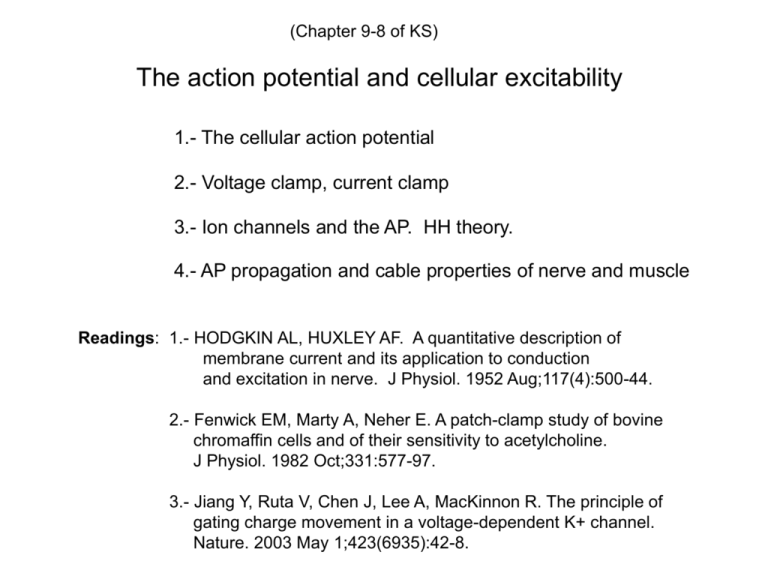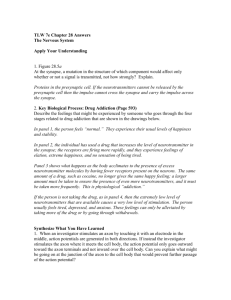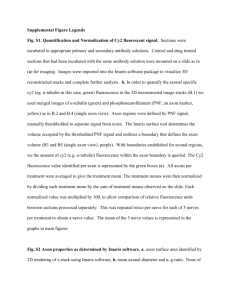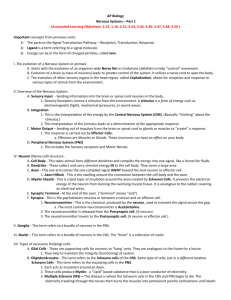Readings
advertisement

(Chapter 9-8 of KS) The action potential and cellular excitability 1.- The cellular action potential 2.- Voltage clamp, current clamp 3.- Ion channels and the AP. HH theory. 4.- AP propagation and cable properties of nerve and muscle Readings: 1.- HODGKIN AL, HUXLEY AF. A quantitative description of membrane current and its application to conduction and excitation in nerve. J Physiol. 1952 Aug;117(4):500-44. 2.- Fenwick EM, Marty A, Neher E. A patch-clamp study of bovine chromaffin cells and of their sensitivity to acetylcholine. J Physiol. 1982 Oct;331:577-97. 3.- Jiang Y, Ruta V, Chen J, Lee A, MacKinnon R. The principle of gating charge movement in a voltage-dependent K+ channel. Nature. 2003 May 1;423(6935):42-8. Keywords: Action potential All-or-none response Threshold, peak, refractory period Overshoot Voltage clamp, current clamp TTX, TEA, Saxitoxin Activation, inactivation, gating currents Ensemble average HH model Space constant, conduction velocity Propagated action potential Problems: 1.- Describe concisely the driving forces of ion flux in excitable cells. What factors determine the direction of ion flux? 2.- Describe the ionic events that underlie the action potential. 3.- Suppose that you have a chromaffin cell under voltage and space clamp conditions. Draw the instantaneous I-V relationship for the K+ conductance. Draw the I-V relationship that you predict results from changing the ionic conditions so that now [K]o= 145 mM and [K]i=5 mM? The three principal cell types to study excitability were the squid giant axon, the node of Ranvier and isolated muscle fibers. Basic properties of action potentials. A, The upper panels show four graded hyperpolarizing stimuli and the Vm responses. The lower panels show four graded depolarizing stimuli and the Vm responses. Note that the two largest stimuli evoke identical action potentials. B, A stimulating electrode injects current at the extreme left of the cell. Four recording electrodes monitor Vm at equidistant sites to the right. If the stimulus is hyperpolarizing, the graded Vm responses decay with distance from the stimulus site. If the stimulus is depolarizing and large enough to evoke an action potential, a full action potential appears at each of the recording sites. However, the action potential arrives at the most distant sites with increasing delay. Nerve and muscle excitability. The curve in A represents the combination of the minimum stimulus intensity and duration that is required to reach threshold and evoke an action potential. Changes in ionic conductance that underlies the action potential. (Data from Hodgkin AL, Huxley AF: A quantitative description of membrane current and its application to conduction and excitation in nerve. J Physiol (Lond) 117:500-544, 1952.) I strongly suggest that you read this paper! It’s a classic and led to their Nobel prize in physiology and medicine. Basic properties of action potentials. A, The upper panels show four graded hyperpolarizing stimuli and the Vm responses. The lower panels show four graded depolarizing stimuli and the Vm responses. Note that the two largest stimuli evoke identical action potentials. B, A stimulating electrode injects current at the extreme left of the cell. Four recording electrodes monitor Vm at equidistant sites to the right. If the stimulus is hyperpolarizing, the graded Vm responses decay with distance from the stimulus site. If the stimulus is depolarizing and large enough to evoke an action potential, a full action potential appears at each of the recording sites. However, the action potential arrives at the most distant sites with increasing delay. Voltage-clamp and space-clamp of a single nerve fiber Dissection of Na+ and K+ currents by voltage-clamp analysis and pharmacology. A, In a typical voltage-clamp experiment, a sudden hyperpolarization from 80 to 140 mV results in a transient capacitative current, but no ionic currents. B, In a voltageclamp experiment, a sudden depolarization from 80 to 20 mV results in a transient capacitative current followed first by an inward ionic current and then by an outward ionic current. C, Blockade of the outward current by tetraethylammonium leaves only the inward current, which is carried by Na+. Conversely, a blockade of the inward current by tetrodotoxin or saxitoxin leaves only the outward current, which is carried by K+. Voltage dependence of ionic currents. Proteins also have a bonded structure that helps them resist the constant bombardment caused by Brownian motion. Small protein ubiquitin A cartoon representation The Bonded structure is dynamic, as it gets bombarded, the structure bends and bonds break and reform How often does Brownian motion overcomes the energy barrier and causes an ion channel to open ? E kT t t0 e E kT t0 ~ 10-12 seconds How long do we have to wait for Brownian motion to overcome an energy barrier ? pico seconds seconds Brownian death E=0 kT 3 Biology 3 kT 35 kT 1067years Too strong 300 kT Control in Biology is accomplished by reducing energy barriers. Then, unlikely events will occur over short time periods DE Local current loops during action-potential propagation. A, The currents flow at one instant in time as a result of the action potential ("active" zone). In the "inactive" zones that are adjacent to the active zone, the outward currents lead to a depolarization. If the membrane is not in an absolute refractory period and if the depolarization is large enough to reach threshold, the immediately adjacent inactive zones will become active and fire their own action potential. In the more distant inactive zones, the outward current is not intense enough to cause Vm to reach threshold. Thus, the magnitudes of the outward currents decrease smoothly with increasing distance from the active zone. B, In this example, the "active" zone consists of a single node of Ranvier. In a myelinated axon, the currents flow only through the nodes, where there is no myelin and the density of Na+ channels is very high. Current does not flow through the internodal membrane because of the high resistance of myelin. As a result, the current flowing down the axon is conserved, and the current density at the nodes is very high. This high current density results in the generation of an action potential at the node. Thus, the active zones jump in a "saltatory" manner from one node to another. The internodal membrane (i.e., underneath the myelin) may not ever fire an action potential. Passive cable properties of an axon. A, The axon is represented as a hollow, cylindric "cable" that is filled with an electrolyte solution. All of the electrical properties of the axon are represented by discrete elements that are expressed in terms of the length of the axon. ri is the resistance of the internal medium. Similarly, ro is the resistance of the external medium. rm and cm are the membrane resistance and capacitance per discrete element of axon length. B, When current is injected into the axon, the current flows away from the injection site in both directions. The current density smoothly decays with increasing distance from the site of injection. C, Because the current density decreases with distance from the site of current injection in B, the electrotonic potential (V) also decays exponentially with distance in both directions. Vo is the maximum change in Vm that is at the site of current injection. The space constant l is given by l for a 1 mm squid axon is 11 mm. l for a 1 mm mammalian nerve is 0.2 mm. Conduction velocity for a giant axon q = 20m/s q~a






